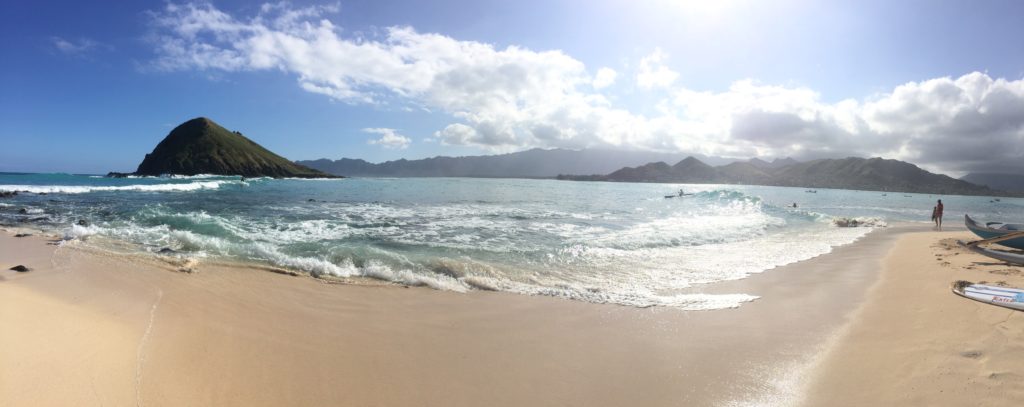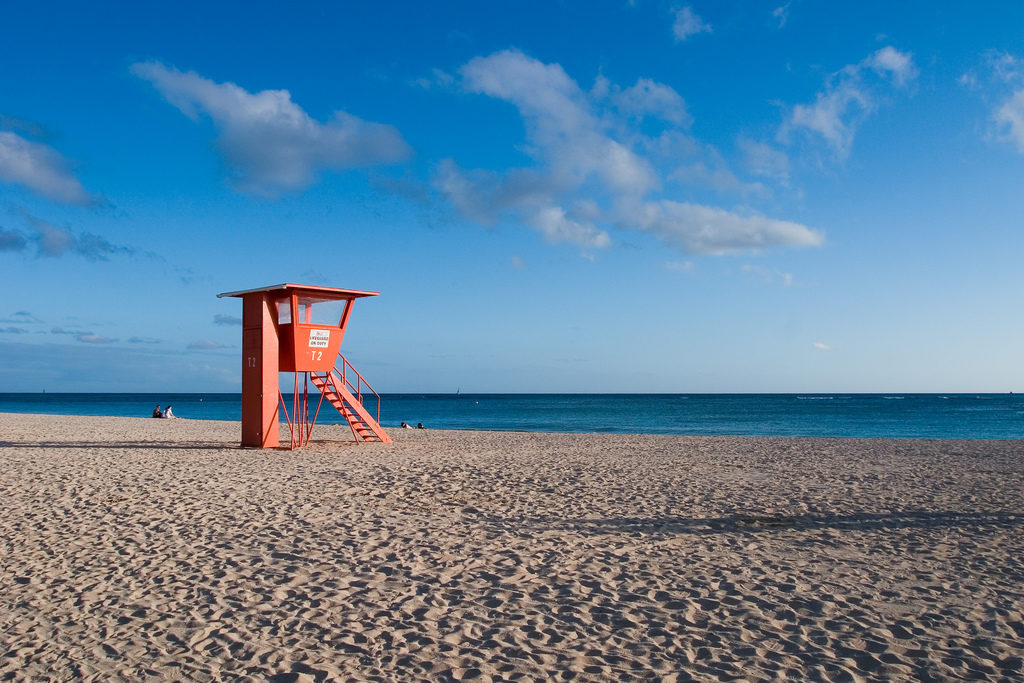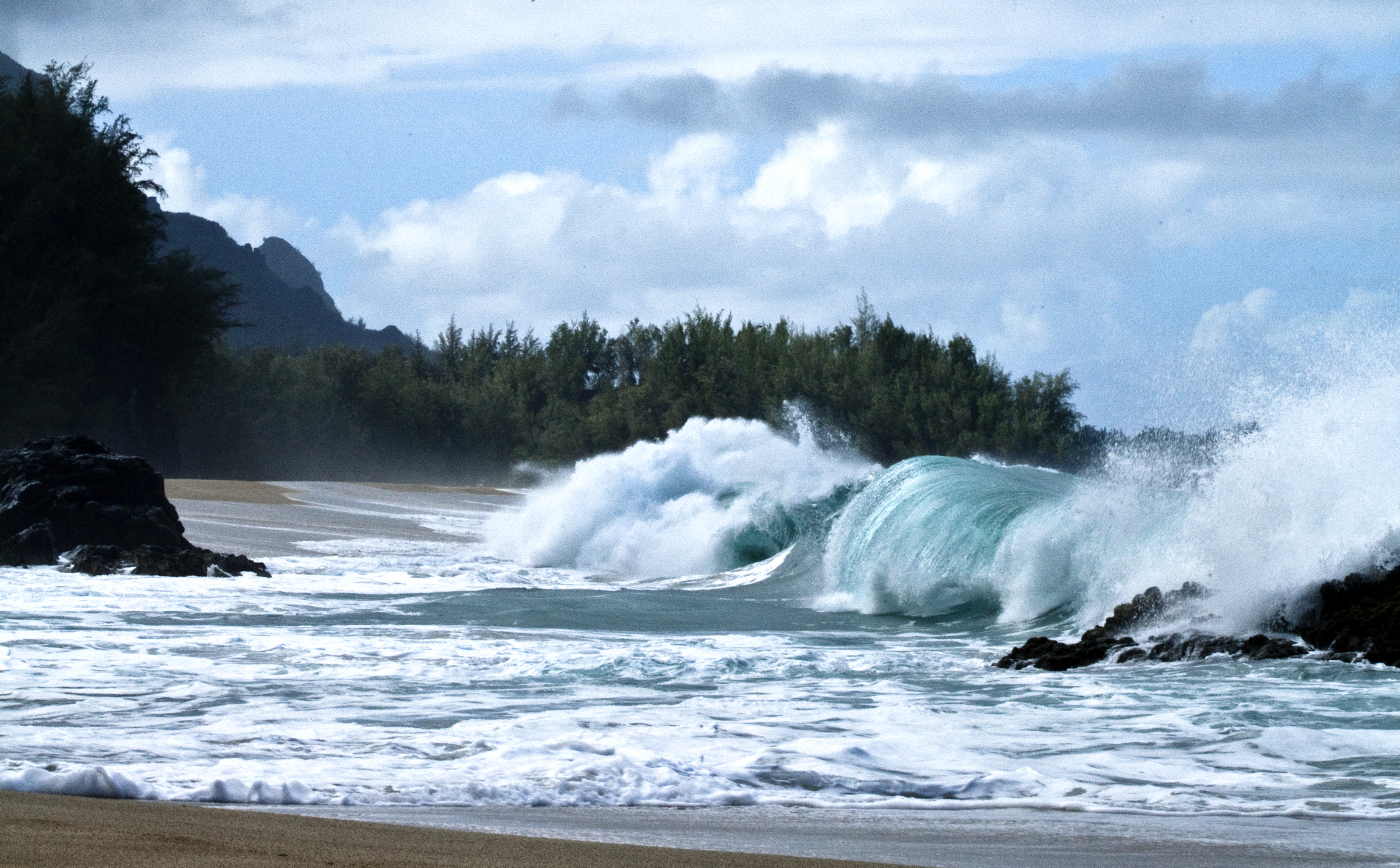There are cautions at beaches in Hawaii, even though long sandy shores seem harmless and easy. Rough surf and undertows can take a person by surprise and unexpectedly drag them out; fighting a current is futile so you need to know these things before you go.
1. Big surf
Beaches that are overlooked by lifeguards will have “big surf” and “dangerous shorebreak” signs up when the waves are too big. In addition, you’ll hear lifeguards speaking over their megaphones announcing that the waves are too rough, even for very strong surfers. However, if these signs aren’t showing (which is rare, because Hawaii’s lifeguards are really awesome,) it’s a good rule of thumb that if the wave is over your head, you shouldn’t go in. Now if you’re a pro 3-time winning Maverick’s champ, then I’m sure you can make your own rules. However, if you’re new to the ocean and especially new to Hawaii, take your time in adjusting to the waves here.

Big Wave Surfing in Tahiti at Teahupoo by 44124400268@N01 is licensed under CC BY-NC 2.0. Image may have been resized or cropped from original. Big surf can be fun to watch, but not fun to get caught up in!
2. Jellyfish
Jellyfish stings can hurt. I’ve never been stung, but both my sister and friends have been stung by portuguese man-o-war and it hurts. These type of jellyfish are very popular on the east side of O’ahu at beaches like Waimanalo and Sherwoods. Jellyfish also come to shore 1 week after a full moon. Lifeguards will also put up “jellyfish” and “portuguese man-o-war” signs to let swimmers know of the water’s hazards. However, they won’t make as big a deal of these guys as they do for the strong shorebreak. It’s still good to know what’s going on, though.

These little guys can really hurt!
Portuguese Man O’ War by warrenski is licensed under CC BY-SA 2.0. Image may have been resized or cropped from original
3. Strong currents
Strong currents can quickly an inexperienced or weak surfer out to sea. Lifeguards are also very keen on keeping beach-goers aware of this with signs on the beach. I would heed these signs if you see these. Although it might not look harmful, currents are invisible but can be destructive and terrifying if you get whipped into one of them unexpectedly. If lifeguards are being cautious about currents, then you should be extra cautious. There are certain currents that have been established for years. Locals are aware of these existing currents, especially the locals that frequent the surf conditions. However, if you’re a newbie, it can be difficult to spot a current, especially without any pre existing knowledge of the area.

Looks beautiful, right? The current here can take you out to sea. Worse, it’s nearly impossible to swim back to shore at this spot! Photo Copyright CyberCom, Inc.
4. Car Break-ins and theft.
At certain beaches, there are car break-ins and theft. For example, china walls (despite its location being in a wealthy neighborhood,) is known for break-ins. I’ve had friends lose valuable items because they left their purses in the car. A good rule of thumb is to not leave any valuables in your vehicle unattended. In addition to this, don’t leave your valuable items unattended on the beach, either. After returning from being in the water, I’ve seen several items surrounding go missing. It’s important to beware of this and always have someone watching your valuables or make sure to have an eye on them from the water. Many surfers, for example, will keep a locked magnetic box in their wheel well to put their keys in.

glass #3 by 45936582@N00 is licensed under CC BY 2.0. Image may have been resized or cropped from original.
5. No lifeguards
Although most beaches in Hawaii come equipped with lifeguards, there are some beaches that don’t. These are primarily the beaches that locals go to. For example, china walls (east O’ahu,) and gas chambers (north shore, Oahu,) don’t have lifeguards guarding these beaches. However, because it’s primarily locals that enjoy these beaches, it’s not a concern for most of them. Most locals are good at detecting dangerous conditions and know when to not get in the water. But, if you’re a traveling tourist, or just new to the islands, beware of these beaches without lifeguards. For example, if you need to be rescued, you’ll have to rely on someone on the beach to risk their life for you instead of a trained lifeguard.

No lifeguard on duty / Waikiki Beach / Oahu / Hawaii / 20060518.10D.39262 / SML by See-ming Lee is licensed under CC BY-SA 2.0. Image may have been resized or cropped from original Life guards are almost at all beaches in Hawaii.


